We mentioned Glitch remake project Odd Giants back in October. It’s incomplete, and the game it seeks to revive was incomplete too, so there’s a lot missing. Still, Glitch (not that Glitch) was beloved among a certain faction of internet people, and some of that magic is still there.
It’s an unusually chill thing to play. To get a sense of the game, here is a promotional Youtube video from 2011, which looks a little different from how the game evolved, but conveys Glitch’s great sense of whimsy:
Now, there are lots of forgotten, abandoned, or failed games that are worthy of a second look, or would be if anyone knew of them. They are an invisible ocean around us, most games that have been made, by far, will disappear unknown and unloved. While many of them perhaps aren’t worth knowing about, some of them definitely are. Just because Stewart Butterfield backed this one doesn’t mean it was any good. But, some people liked it, and remember it fondly, and I’m one of them. We like old and forgotten pastimes here at Set Side B, and want to tell as many people about them as we can, as long as we are able.
Glitch was a Flash-based web MMORPG platformer. You played as a glitch, plural glitchen, a humanoid creature living in the land of Ur, which existed within the thoughts of eleven godlike Giants. (Eleven is kind of a sacred number in Glitch and Ur.)
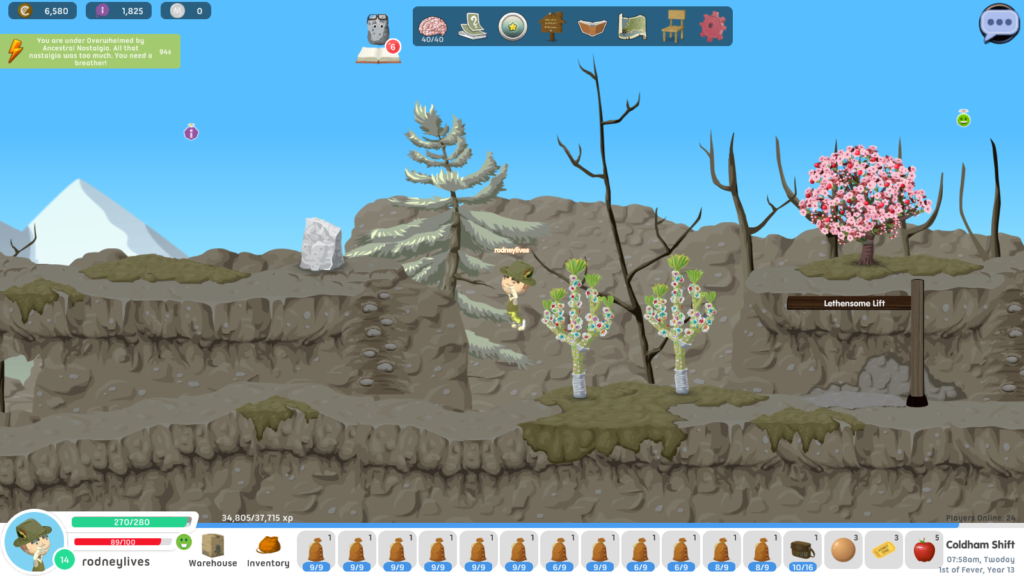
Glitch was created in Flash, and it was already in the outs back then, preventing iOS players from entering. Since Flash is unusable in browsers any more (without alternate runtimes like Ruffle), Odd Giants is implemented in Unity, which means you can’t just jump into the game by browsing to a site, and that you have to download a 1.2 gigabyte client to play. And you’ll have to download a new one when there’s a major update. But on the other hand it means all of the game’s graphics are stored on your computer, greatly speeding load and transition times. I think I prefer to play it this way.
As I said, Glitch was created by Stewart Butterfield, the creator of Flickr and, later, Slack. (In fact, Slack’s communication code has its basis in the chat system from Glitch.) In a move atypical of many rich tech bizzes, when Glitch shut down, its production studio Tiny Speck donated nearly all of the game’s assets to the public domain, which is what makes Odd Giants, and other Glitch remake projects like Children of Ur and Eleven, legal. (Tiny Speck renamed themselves to Slack, but it’s the same company. They just make business communications software now instead of a laid back exploratory MMORPG platformer.)
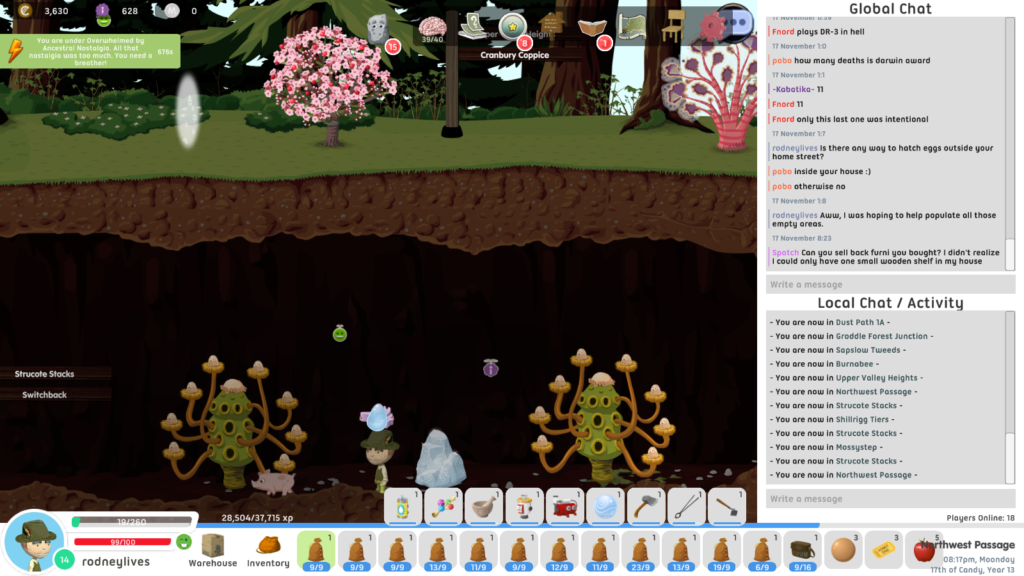
Glitch, and thus its revival/remake Odd Giants, is a platformer, but it eschews many of the basic principles of platformers. There are no enemies, you never die from falling off the screen, and dangers are few. Platforming, running and jumping, is mostly just a way of getting around and collecting “quoins,” little objects floating around the games many areas. If you never lost that basic joy of running Mario around terrain without having to stomp on things or dodge hammers, you’ll have fun in Odd Giants.
Since the world of Ur is in the Giants’ thoughts you don’t actually encounter them directly as creatures in the game, but their presence is felt in many ways. Particularly, there are shrines to them all over, where you can donate objects for their favor, and eventually earn Emblems and Icons devoted to them.
The world of Ur is divided into a number of regions, each divided into a hash of streets, which are shown on the region map as lines. Here’s a map of Groddle Forest, the starting area:
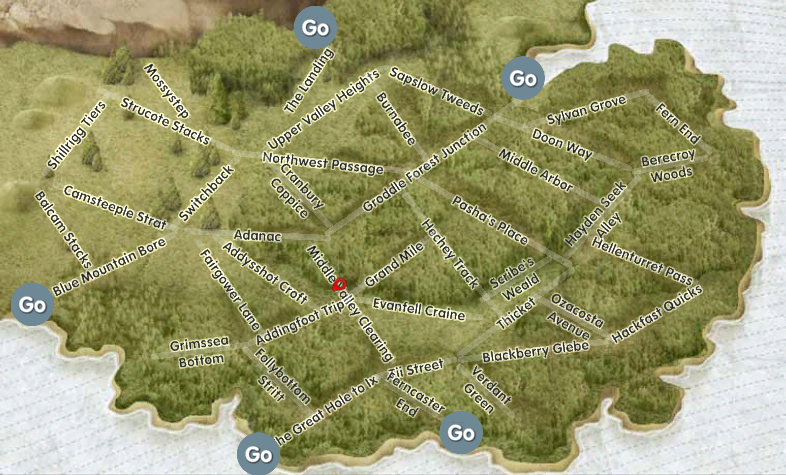
Each street’s left-right scroll corresponds to its in-game area. If you’re standing at the left edge of a street in the game, you’ll also be at its left edge on the map. Where the streets connect on the map, there are signposts in the game that allow you to transfer to connecting streets. It’s not a completely frictionless way of navigating the game’s regions, but it’s easy to get used to.
If there are no enemies, then what do you do in Ur? Mostly you just run around and collect Quoins, and also water trees, harvest fruit, mine rocks, squeeze chickens, milk butterflies, nibble on piggies, and other miscellaneous activities. These actions are initiated by clicking on an object and selecting the action from a menu. When you do, a progress meter appears, which fills quickly. Most actions just take two or three seconds. As you advance, you become able to more things like make meals or transmute metals, that build off of the things you did at the start.
There is no solid final goal. It’s just a world to explore and have fun in. Without enemies to fight, some people will find this pointless. That’s okay. It was always something that some people would find unappealing. But if you like the idea of a non-violent game where you can talk with friends and do silly things in, then you may enjoy playing Odd Giants.
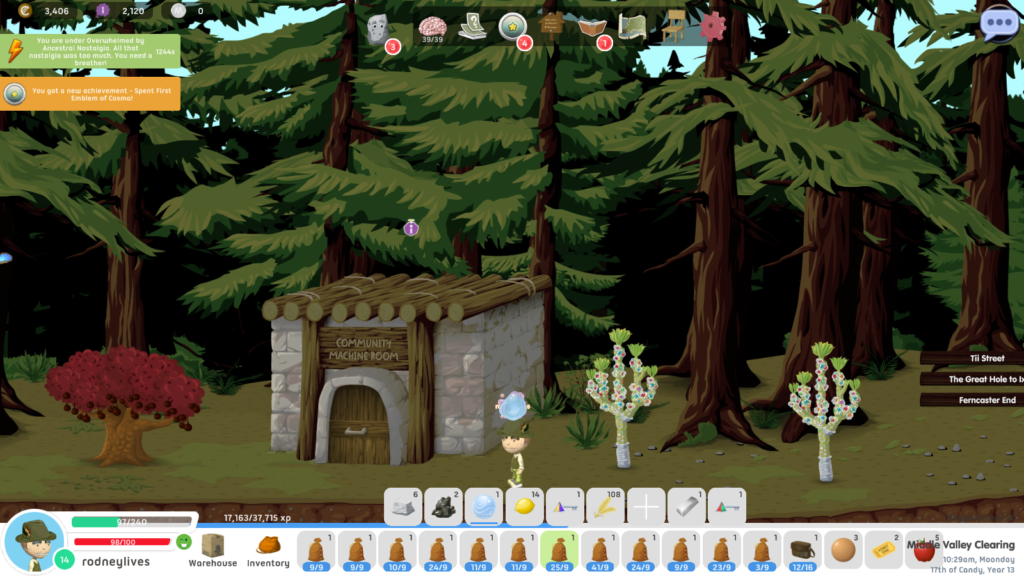
Aiding in this is a great sense of whimsy and fun that suffuses almost everything aspect of the play. The graphics are charming throughout, with well-animated creatures and many scenic vistas to explore. Almost every text sentence in the game has a joke or two in it. Just playing to see whatever funny thing to see or read next can be entertaining, for a little while at least. The music, especially, is worth checking the game out for a little while. I don’t think I’ve heard a single track that isn’t great.
As you do things, you use up your Glitch’s Energy. If you run out of energy, your little person “croaks” and ends up in Hell! But Hell is a region of streets, just like the others. It’s not hard to get out of Hell. You just run around squishing grapes lying on the ground. Squash enough and you’ll be returned right where you were, although without much energy. You could even spend a Get Out Of Hell Free card, if you’ve found one, and bypass that whole process. A lot of the negative things in Glitch/Odd Giants are pretty light like this. No punishment ever really feels punishing, although it may interrupt what you were doing for a bit.
In addition to Energy, glitches have Mood, which slowly depletes and decreases rewards if it dips too low, and “iMG,” or Imagination, a general advancement currency used to pay for Upgrades and other features, like expanding your house. There’s also experience points, or “XP,” which contributes to a glitch’s experience Level, but Level doesn’t affect the game much at all. It just seems to gate being able to use a few high-end items that you probably won’t even see for a while.
Instead of level, most of your character’s advancement comes from buying Upgrades and learning Skills. Some Upgrades are things like being able to walk faster and getting a triple jump, but most are things like increasing your maximum Energy, increasing the bonuses you get for Quoins, or getting bonus items randomly while doing things, or other things of that nature. Upgrades are bought with iMG, and are offered from a “deck” three at a time. You can buy any that are offered, but to get new options you’ll have to “reshuffle.” This will put the unbought upgrades back into the deck and deal you three new ones. As you buy Upgrades and remove them from play, the deck is seeded with more powerful, and much more expensive, replacements. Every game day (which last for four hours of real time) you’re allowed two free reshuffles, with them growing in price after that. There are also some other special upgrades that can be bought repeatedly, like Get Out Of Hell Free cards, extra Reshuffles, and access to special bonus areas (that, unfortunately, mostly don’t work yet in Odd Giants).
Most Upgrades are nice extras. The need to have Skills, on the other hand, blocks access to more major game features. There’s a complex array of Skills, many requiring other Skills, or particular accomplishments, under your belt before you can learn them in a kind of skill tree. Each skill takes real time to learn, which pass whether you’re in-game or not. Some skills take hours, or even days, to learn.
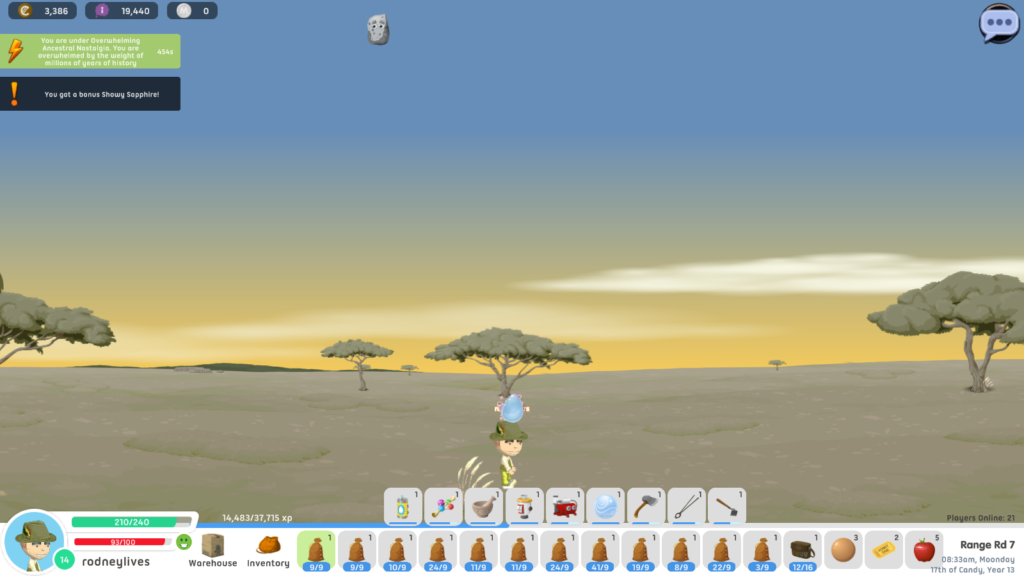
You start out with the capacity to know ten Skills. Back in Glitch, you could still learn skills if you were over capacity, but they took even longer. In Odd Giants, at least for now, your capacity is a hard limit, but you can raise it with Upgrades.
Some Skills are really basic things, like access to the Info command on objects, or access to the map. Most of them give you new powers, like being able to teleport places, or allow you to use items like the Meditation Orb. Many things are blocked until you learn the requisite skill, so it’s good to always make sure you have one learning, if you have excess capacity, when you log off from the game.
It cannot be denied, though, that sometimes the game feels like a gussied-up skeleton of progression systems with a visual veneer. You can make some cool items later on, like “Essence of Purple” or “No-No Powder,” but you’ll have to master many skills to get to that point. Glitch had a number of mini-games to discover that you could play at low levels by finding Game Show Tickets, and bonus levels you could buy at the Upgrade shop, but none of those things work currently. It makes the early going a bit of a slog, but the players in the game tend to be very friendly and helpful, and willing to give new players advanced items just for asking.
Details to get you started
It’s fun to collect quoins, those little floating powerup items that are scattered in many streets, but truthfully they don’t earn you much. Once in a while a quoin will give you a larger-than-usual bonus, but it’s infrequent, and rarely enough to bother going out of your way to collect them. Still, they’re fun to pick up, so I usually do it anyway.
Your Energy cap is a major limiter of your activity. Food items usually restore Energy, so it’s good to stock up on those. Learning the skill Meditation I lets you use a Meditation Orb, which allows you to regenerate a random amount of Energy or Mood when you want, with only a 30 second timeout to using it repeatedly. I would try to get that as soon as possible.
You’ll want to earn lots of iMG to unlock Upgrades and expand your yard and home. Most things you do will earn you at least a tiny bit of iMG. When you get the Skills to use machines to make stuff, you can usually convert several items at once, which can get you more for less work. A lot of your iMG will come from Achievements, which the game tracks in the background for you, and Quests, which are usually randomly assigned.
There is a bug in the current version (0.14.1), as I write this, that allows you to get all the rewards for most Quests without having to do them. Just cancel the Quest from the quest screen, then exit the game and reenter. You’ll have to wait 30 seconds before coming back in, but when you do you’ll get the full reward! One of the Quests, the one that asks you to construct an Icon, is extremely time-consuming to complete, but has high rewards. This can be used to help fund some of the most expensive Upgrades.
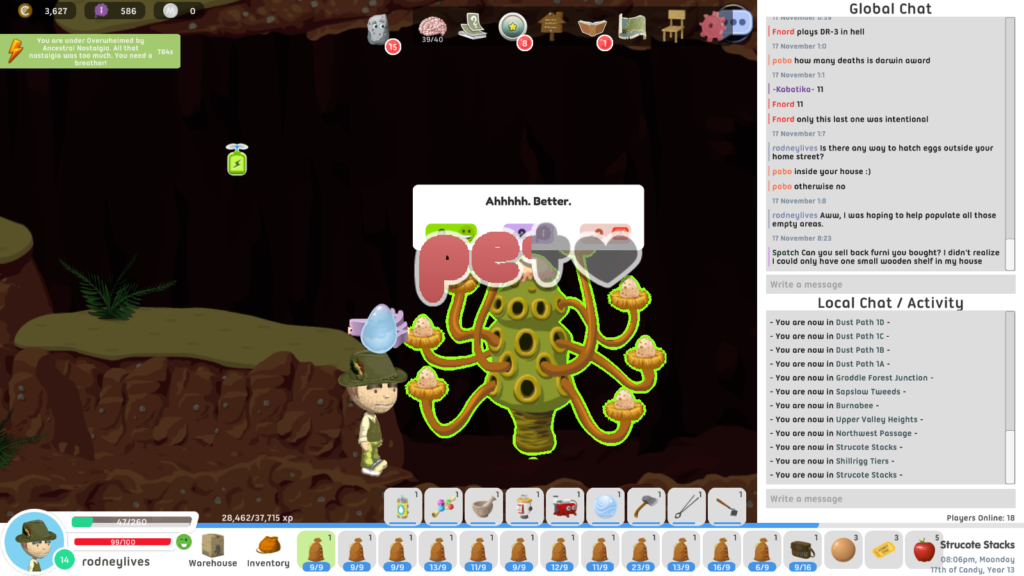
You can gain a lot of iMG every game day by using Emblems and Icons. There are shrines to the 11 Giants around many areas. You can click on one to donate items to it, which awards you an amount of iMG, and well as favor with that Giant, depending on the value (in the game’s money, called Currants) of the item. If you built up 1,000 points of favor with a Giant, you can exchange it for an Emblem for that Giant. (In 0.14.1, the first time you do this with each Giant you’ll receive two Emblems, which is good since you can immediately spend one to unlock an important skill!) Using an Emblem’s Contemplate command can be worth 30 iMG per Emblem of that Giant you’re holding. That takes up a lot of inventory space, so you’ll want to invest in bags, which you can buy from vendors to carry more. It takes a significant number of Currants to outfit yourself with full Bigger Bags, but it’s ultimately worth it because you can carry so many more Emblems, and all kinds of other things too.
If you collect 11 Emblems, you can combine them into an Icon, which can be set on the ground and be Reflected upon, for even more iMG. In the Groddle Heights region, at the moment, there are a number of Icons set up on the ground for people to use, although sometimes they require a small Currant payment. If you can find your way to Xalanga, the region Zealous Rd NE currently has all 11 kinds of Icons set up for easy use.
Some features are not yet coded. Some of these are in the game as Upgrades or Skills that don’t work once acquired. There is no indication which these are, which sucks, but what can I say the game’s under heavy development. One of these as of this writing are the ability to unlearn skills to make room for others, and most of the bonus levels you can buy as Upgrade cards.
At the moment lots of areas have terrain but not much of interest to find in them. Many of the special areas don’t yet work. One that does, at least, are the Savannah areas, among them Choru, Xalanga, Zhambu, Baqala, and some others. Try navigating there if you want to find a lot of valuable items quickly.
There are some other things to do if you explore a bit, but many things that were in Glitch are not yet implemented. It’s a bit wild and woolly in that regard, but presumably that kind of stuff will be implemented eventually. As it is, it’s still fun to log in, customize your character (click on their portrait in the bottom-left corner of the window), and run around and explore.
More information
An archived version of the wiki for Glitch is here. There’s also a lot of information left up at the game’s website.
While constructing this post I rummaged through the Metafilter archives (which are a great resource) and found a number of related posts:
On Game Neverending (a predecessor of Glitch). On how it gave rise to Flickr. On Glitch itself. On Katamari Damacy creator Keita Takahashi joining up with Tiny Speck. On Glitch’s closing. On Keita Takahashi’s idea journal. On the grant of Glitch’s assets to the public domain. On the Glitch Forever wiki revival.
